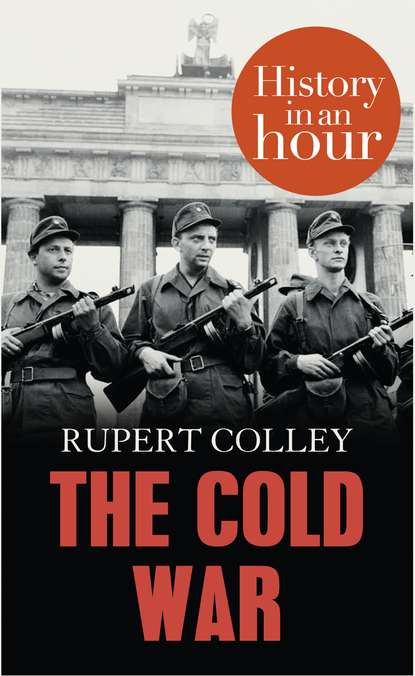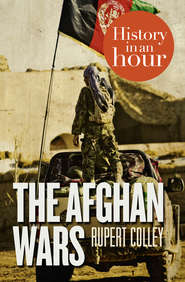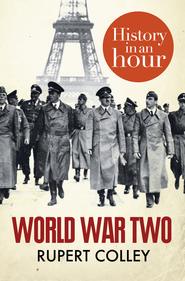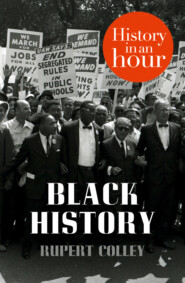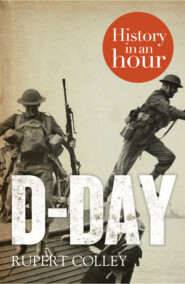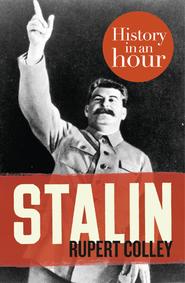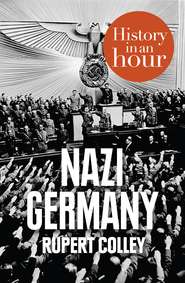По всем вопросам обращайтесь на: info@litportal.ru
(©) 2003-2024.
✖
The Cold War: History in an Hour
Настройки чтения
Размер шрифта
Высота строк
Поля
The Cold War: History in an Hour
Rupert Colley
Love history? Know your stuff with History in an Hour.From the end of World War Two to the collapse of the Soviet Union in 1991, Russia and America eyed each other with suspicion and hostility as the world lived in the shadow of the Cold War. As post-war Europe was rebuilt, Churchill, Roosevelt and Stalin struggled to maintain peace among the former Eastern and Western Allies. Two ideologies, two political systems, two cultures, two superpowers became entrenched in a fight for dominance, each firm in the belief that history would prove them right.The Cold War: History in an Hour is the concise account of the political tensions that arose as the world rebuilt after World War Two – an era beset by the constant fear of nuclear weapons and the looming threat of a Third World War.Love history? Know your stuff with History in an Hour…
THE COLD WAR
History in an Hour
Rupert Colley
About History in an Hour (#ulink_f55679fa-1a3c-5d5c-8f1e-106a887a7c2a)
History in an Hour is a series of ebooks to help the reader learn the basic facts of a given subject area. Everything you need to know is presented in a straightforward narrative and in chronological order. No embedded links to divert your attention, nor a daunting book of 600 pages with a 35-page introduction. Just straight in, to the point, sixty minutes, done. Then, having absorbed the basics, you may feel inspired to explore further.
Give yourself sixty minutes and see what you can learn . . .
To find out more visit http://historyinanhour.com (http://historyinanhour.com) or follow us on twitter: http://twitter.com/historyinanhour (http://twitter.com/historyinanhour)
Contents
Cover (#ub297db18-0e67-59d4-9b78-7935e13b81b1)
Title Page (#u1af9ba53-7b99-5082-8934-df3eb177c2cf)
About History in an Hour
Introduction
The End of the Second World War: Apocalypse
The Beginning of the Cold War: The Freeze
Three Speeches: ‘An iron curtain has descended’
The Marshall Plan: ‘Communism cannot be stopped in Europe’
Berlin: ‘You should not and cannot abandon this city and this people’
The Bomb: ‘MAD’
The Korean War: Hot War
US Anti-Communism: ‘Reds Under the Bed.’
Stalin’s Final Years: ‘I’m finished, I don’t even trust myself’
Khrushchev: ‘Different roads to socialism’
Space Wars: ‘Flopnik’
The Berlin Wall: ‘Berlin is the testicles of the West’
The Cuban Missile Crisis: ‘We’ll all meet together in Hell’
The Vietnam War: Unwinnable
Rebellion: 1968
Nixon: ‘Vietnamization’
China, the USA and the Soviet Union: ‘Ping-pong diplomacy’
The Decline of Détente: ‘Lennonism, not Leninism’
Afghanistan: ‘The Soviet Vietnam’
The Polish Pope and Solidarity: ‘The last nails in the coffin of communism’
The Ex-Actor: ‘Regimes planted by bayonets do not take root’
Gorbachev: ‘Mr Gorbachev, tear down this wall!’
1989: ‘Time to yield power’
The End of the Soviet Union: ‘The threat of a world war is no more’
Appendix 1: Key Players
Appendix 2: Timeline of the Cold War
Copyright
Got Another Hour?
About the Publisher (#litres_trial_promo)
Introduction (#ulink_6a8d9c6b-363e-525c-a2cc-2315bac8dde2)
From the end of the Second World War to the collapse of the Soviet Union in 1991 the world lived within the shadow of the Cold War. For almost half a century the East and the West eyed each other with suspicion and often hostility. Two ideologies, two political systems, two cultures, two superpowers fought for dominance, each firm in the belief that history would prove them right. And all the time the threat of a Third World War remained a distinct possibility, the spectre of nuclear weapons a constant fear. This, in an hour, is how it happened.
The End of the Second World War: Apocalypse (#ulink_2688910c-5d1b-59e8-b9cf-cadff5ca4def)
Winston Churchill, Britain’s wartime prime minister, said of Stalin, he would ‘work with the Devil if it would help defeat Hitler’. Towards the end of the Second World War, with the defeat of Hitler’s Germany only a matter of time, the ‘Big Three’ – Churchill, Joseph Stalin and the US president, Franklin D. Roosevelt (pictured below) – met a number of times to discuss their strategy for winning the war and the make-up of a post-war Europe. US soldiers, advancing on Berlin from the west, and Soviet soldiers from the east, met on the River Elbe on 25 April 1945. Amidst the handshakes and toasts they promised everlasting friendship between the two nations. But while the soldiers visualized a bright future of camaraderie and peace, the Big Three had already begun carving Europe up between the East and the West.
Churchill, Roosevelt and Stalin, February 1945
With the Red Army taking Berlin and indulging in an orgy of mass rape against German women, Hitler, deep within his bunker, committed suicide on 30 April. A week later, on 7 May, Germany surrendered unconditionally. The war – in Europe, at least – was over.
In the Far East, Japan, although on the brink of starvation and collapse, its armed forces shattered, refused to do likewise. The Americans, having successfully tested the first atomic bomb on 16 July, used this new apocalyptic weapon on the Japanese city of Hiroshima on 6 August, followed, three days later, with a second on Nagasaki. Finally, the Japanese surrendered. After six years and a day, the Second World War had ended. And the Cold War began.
Rupert Colley
Love history? Know your stuff with History in an Hour.From the end of World War Two to the collapse of the Soviet Union in 1991, Russia and America eyed each other with suspicion and hostility as the world lived in the shadow of the Cold War. As post-war Europe was rebuilt, Churchill, Roosevelt and Stalin struggled to maintain peace among the former Eastern and Western Allies. Two ideologies, two political systems, two cultures, two superpowers became entrenched in a fight for dominance, each firm in the belief that history would prove them right.The Cold War: History in an Hour is the concise account of the political tensions that arose as the world rebuilt after World War Two – an era beset by the constant fear of nuclear weapons and the looming threat of a Third World War.Love history? Know your stuff with History in an Hour…
THE COLD WAR
History in an Hour
Rupert Colley
About History in an Hour (#ulink_f55679fa-1a3c-5d5c-8f1e-106a887a7c2a)
History in an Hour is a series of ebooks to help the reader learn the basic facts of a given subject area. Everything you need to know is presented in a straightforward narrative and in chronological order. No embedded links to divert your attention, nor a daunting book of 600 pages with a 35-page introduction. Just straight in, to the point, sixty minutes, done. Then, having absorbed the basics, you may feel inspired to explore further.
Give yourself sixty minutes and see what you can learn . . .
To find out more visit http://historyinanhour.com (http://historyinanhour.com) or follow us on twitter: http://twitter.com/historyinanhour (http://twitter.com/historyinanhour)
Contents
Cover (#ub297db18-0e67-59d4-9b78-7935e13b81b1)
Title Page (#u1af9ba53-7b99-5082-8934-df3eb177c2cf)
About History in an Hour
Introduction
The End of the Second World War: Apocalypse
The Beginning of the Cold War: The Freeze
Three Speeches: ‘An iron curtain has descended’
The Marshall Plan: ‘Communism cannot be stopped in Europe’
Berlin: ‘You should not and cannot abandon this city and this people’
The Bomb: ‘MAD’
The Korean War: Hot War
US Anti-Communism: ‘Reds Under the Bed.’
Stalin’s Final Years: ‘I’m finished, I don’t even trust myself’
Khrushchev: ‘Different roads to socialism’
Space Wars: ‘Flopnik’
The Berlin Wall: ‘Berlin is the testicles of the West’
The Cuban Missile Crisis: ‘We’ll all meet together in Hell’
The Vietnam War: Unwinnable
Rebellion: 1968
Nixon: ‘Vietnamization’
China, the USA and the Soviet Union: ‘Ping-pong diplomacy’
The Decline of Détente: ‘Lennonism, not Leninism’
Afghanistan: ‘The Soviet Vietnam’
The Polish Pope and Solidarity: ‘The last nails in the coffin of communism’
The Ex-Actor: ‘Regimes planted by bayonets do not take root’
Gorbachev: ‘Mr Gorbachev, tear down this wall!’
1989: ‘Time to yield power’
The End of the Soviet Union: ‘The threat of a world war is no more’
Appendix 1: Key Players
Appendix 2: Timeline of the Cold War
Copyright
Got Another Hour?
About the Publisher (#litres_trial_promo)
Introduction (#ulink_6a8d9c6b-363e-525c-a2cc-2315bac8dde2)
From the end of the Second World War to the collapse of the Soviet Union in 1991 the world lived within the shadow of the Cold War. For almost half a century the East and the West eyed each other with suspicion and often hostility. Two ideologies, two political systems, two cultures, two superpowers fought for dominance, each firm in the belief that history would prove them right. And all the time the threat of a Third World War remained a distinct possibility, the spectre of nuclear weapons a constant fear. This, in an hour, is how it happened.
The End of the Second World War: Apocalypse (#ulink_2688910c-5d1b-59e8-b9cf-cadff5ca4def)
Winston Churchill, Britain’s wartime prime minister, said of Stalin, he would ‘work with the Devil if it would help defeat Hitler’. Towards the end of the Second World War, with the defeat of Hitler’s Germany only a matter of time, the ‘Big Three’ – Churchill, Joseph Stalin and the US president, Franklin D. Roosevelt (pictured below) – met a number of times to discuss their strategy for winning the war and the make-up of a post-war Europe. US soldiers, advancing on Berlin from the west, and Soviet soldiers from the east, met on the River Elbe on 25 April 1945. Amidst the handshakes and toasts they promised everlasting friendship between the two nations. But while the soldiers visualized a bright future of camaraderie and peace, the Big Three had already begun carving Europe up between the East and the West.
Churchill, Roosevelt and Stalin, February 1945
With the Red Army taking Berlin and indulging in an orgy of mass rape against German women, Hitler, deep within his bunker, committed suicide on 30 April. A week later, on 7 May, Germany surrendered unconditionally. The war – in Europe, at least – was over.
In the Far East, Japan, although on the brink of starvation and collapse, its armed forces shattered, refused to do likewise. The Americans, having successfully tested the first atomic bomb on 16 July, used this new apocalyptic weapon on the Japanese city of Hiroshima on 6 August, followed, three days later, with a second on Nagasaki. Finally, the Japanese surrendered. After six years and a day, the Second World War had ended. And the Cold War began.





